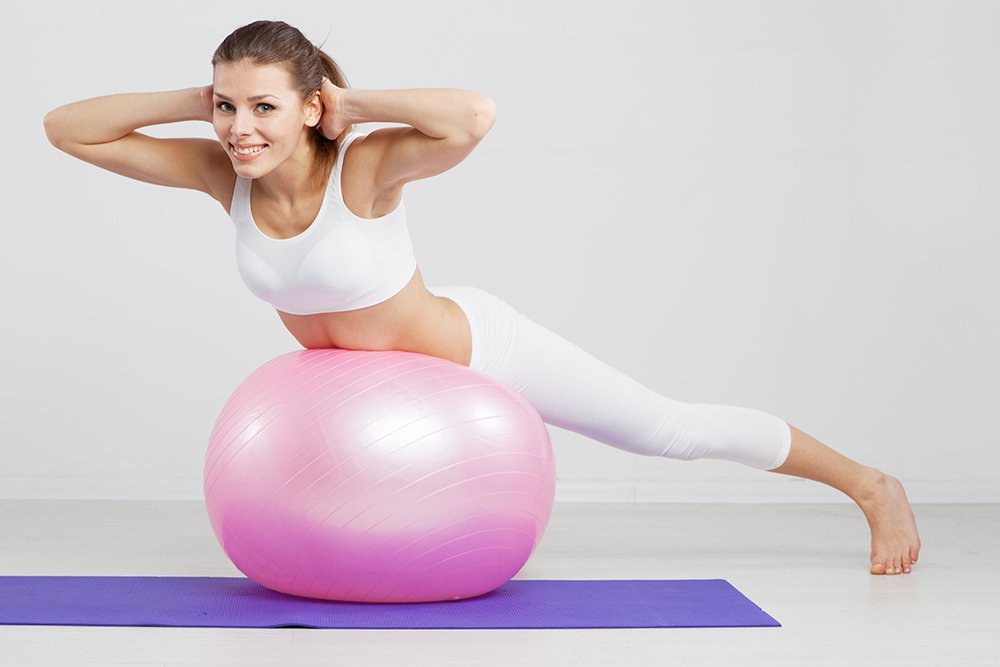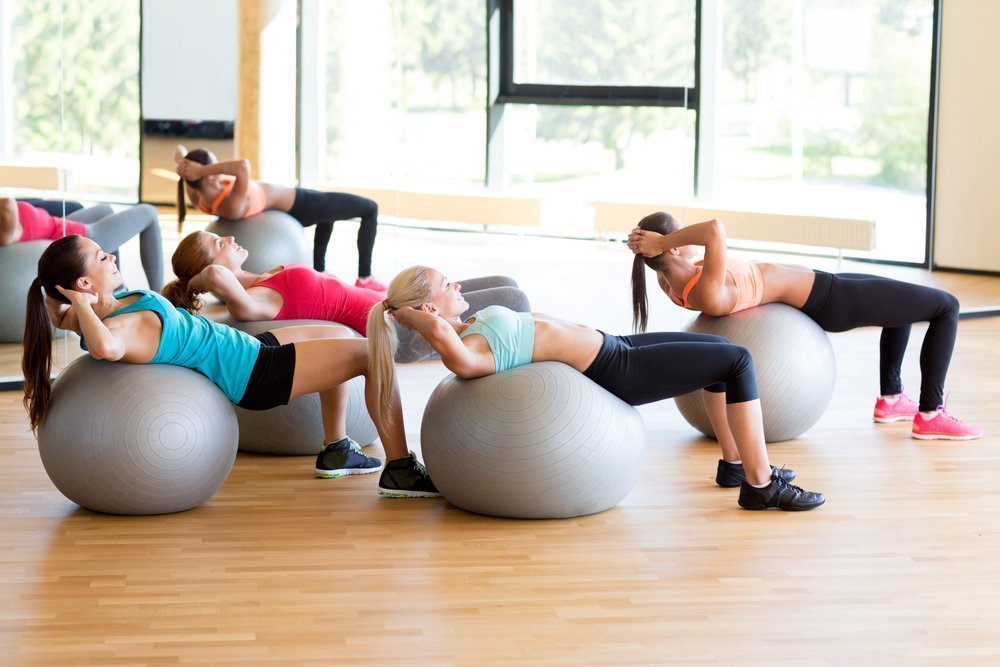The large gymnastic ball (fitness ball or Swiss ball), was originally intended for rehabilitation of people after operations and injuries, as well as those suffering from cerebral palsy. Gradually it was introduced into the world of fitness and became especially popular among home exercise enthusiasts.
This is due to the fact that in order to maintain balance a large number of muscles need to be tensed, including those that are difficult to work out with regular physical exercises.
Choosing a fitness ball
In order to properly perform exercises for weight loss and strengthening the body, it is necessary to choose the right gymnastic ball. The first criterion to be considered when buying a fitness ball is the ratio of its diameter to the height of the exerciser.
- For people whose height is less than 152 cm, a projectile with a diameter of 45 cm is required.
- For people between 152 cm and 164 cm tall, a 55 cm ball will do.
- For people between 164 cm and 180 cm tall, a 65-cm fitness ball is optimal.
- Those whose height exceeds 180 cm will need a ball 75 cm in diameter.
Before buying, it is necessary to “try on” the ball on yourself. When sitting on a properly fitted fitball, the legs form a right angle at the knees. There is a special feature for pregnant women: the knees should be slightly raised – this will ensure a comfortable position of the belly between the legs in the last trimester.
Next, it is necessary to carefully inspect the ball and find out its main characteristics. If there is an unpleasant smell from the projectile, then it is made of cheap rubber, which will not be able to withstand heavy loads. It is necessary to clarify with the seller, whether the fitball has an anti-explosion system, which provides a smooth release of air from the ball in the case of a puncture. This is especially important for people who are undergoing rehabilitation, as well as for pregnant women, because a fall from a ruptured ball during a fitness exercise can negatively affect the health of the future mother and the baby.
When the projectile is inflated, its surface should give a feeling of tightness and be elastic. The seams should not be felt when resting your hand on the surface. Fitball can be with handles – this option is optimal for small children. Also the gymnasium can have a massage surface to stimulate blood circulation. Choosing a fitball, you need to properly pump it, because over-pumped ball is less stable and it will be harder to stay on it.
Proper exercise on a ball

Physical exercises with a ball require preparation of the place to practice. Choose a free space in the room away from large and sharp objects. In the initial stages, you can put a towel roller under the ball to make it more stable. This will help make it easier to get used to the new kind of load; then classes are held without additional stoppers.
An important aspect of fitness is proper breathing. Trying to keep a balance, a person involuntarily holds his or her breath, preventing the body from working in the right mode. This situation should be avoided and the breathing process should always be controlled. Proper seating on the ball will help in this: sit with a straight back, put your feet together. Working the abdominal muscles, maintain the correct position and monitor the frequency of breaths and exhalations.
Beginners should consider the following points when putting together a fitness training program:
- In the first classes, you can stick your hand to the wall if you can’t keep your balance on your own;
- exercises for weight loss repeat 10-15 times and perform them in 1-3 approaches;
- If painful sensations arise during the performance of a fitness element, it is necessary to make sure that the technique is correctly followed, as failure to comply with it may lead to injury;
- If fitness exercises are necessary for rehabilitation after an injury, it is necessary to consult the attending physician, and in some cases – the supervision of an instructor of physical therapy.
Each session begins with a light warm-up to prepare the body for activity. At the end of the workout, stretching is done to restore the shape of the muscles.
Fitness exercises with a ball are convenient because you can adapt familiar elements to them. Over time, you will be able to choose your own training programs, paying more attention to problem areas. Newcomers to HLS can use the following set of exercises for weight loss:
- Lower yourself onto the floor on your back (for convenience, you can put a gymnastic mat or a thick blanket), bend your legs at the knee joints, place the ball between your feet, squeezing it tightly.
Rhythmically raise the legs and pull them toward you, then pull them back.
- Staying in the same position with the ball clamped on the feet, begin lowering the feet first to one side and then to the other.
Twist the body as much as possible, but with good flexibility, make sure that the feet do not drop to the floor.
- Remain in the supine position, with feet resting on the ball so that the shins lie on the surface of the fitball.
Palms together at the back of the head, take the shoulders off the floor and stretch their chests to their knees. After that, return to the starting position and repeat the exercise as many times as necessary.
- Place the ball in front of you, rest your elbows on its surface, feet on the floor.
The whole body is pulled in one line. Hold this position for as long as you are strong enough.
- Lie on the ball with your belly, roll slightly forward so that it is in the thighs, legs outstretched, hands resting on the floor.
Tensing the muscles of the back and lower back, raise the legs as high as possible.
- Sit on a fitness ball, roll over it with your back so that the ball is under your lower back.
Feet rest on the floor, hands on the other side of the projectile also touch the surface of the floor. As you exhale, lift your upper body, hold the pose for a few seconds, and then lower yourself back down.
- Staying in the supine position on the ball, move it under the hips.
Hands resting on the floor. Extend the legs and roll the fitball, shifting it to the toes. Hold this position for a few seconds, then return to the starting position.
- Sit on the ball, feet on the floor.
Work your buttocks and abs to roll the ball underneath you from side to side.
Regular exercise on a gymnastic ball can help strengthen muscles, reduce weight, and develop a sense of balance.
The articles on this site are for information purposes only. The site administrators are not responsible for attempting to apply any recipe, advice or diet, nor do they guarantee that the information provided will help or harm you personally. Be cautious and always consult a doctor or nutritionist!
*All products recommended by thefirstdoc.com are selected by our editorial team. Some of our articles include affiliate links. If you buy something through one of these links, you help us earn a small commission from the seller and thus support the writing of useful and quality articles.





